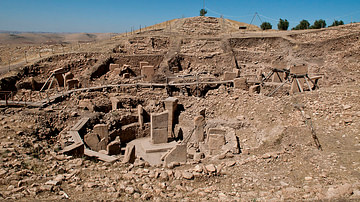Deep within the heartland of Anatolia lies a captivating archaeological site that has puzzled researchers for decades. Welcome to Göbekli Tepe, an enigmatic ancient complex shrouded in mystery and intrigue. This remarkable discovery challenges our understanding of human history and offers a glimpse into lost civilisations that once thrived in this region.
A Glimpse into Prehistoric Anatolia
As we delve into the depths of time, Göbekli Tepe emerges as a testament to the ingenuity and sophistication of our ancestors. Dating back over 11,000 years, this prehistoric site predates Stonehenge by thousands of years and even surpasses the construction techniques employed during Egypt’s pyramids era.
The monumental stone pillars at Göbekli Tepe stand tall, adorned with intricate carvings depicting animals such as lions, snakes, foxes, and birds. These masterfully crafted sculptures provide valuable insights into early symbolism and religious practices that were prevalent among these ancient societies.
Archaeologists have unearthed evidence suggesting that this awe-inspiring sanctuary served as a gathering place for ritualistic ceremonies or perhaps even sacred burials. The sheer scale and complexity of its architecture challenge conventional notions about hunter-gatherer communities’ capabilities during this period.
An Archaeological Puzzle Yet to be Solved
Göbekli Tepe continues to baffle experts due to its sudden abandonment around 8,000 BCE. The reasons behind its demise remain elusive; however, theories range from climate change-induced agricultural collapse to social upheaval or cultural shifts within these early societies.
This extraordinary archaeological find raises questions about how humans transitioned from nomadic lifestyles to settled communities, challenging the traditional narrative of civilization’s development. The intricate carvings and stone pillars at Göbekli Tepe suggest a level of social organization and cooperation that was previously thought to have emerged much later in human history.
Furthermore, the discovery of this ancient site has prompted researchers to reconsider Anatolia’s significance as a cradle of civilisation. It challenges long-held beliefs about Mesopotamia being the sole birthplace of complex societies, highlighting the need for further exploration and reevaluation of our understanding of early human cultures.
Unveiling Lost Civilisations
Göbekli Tepe stands as a testament to the ingenuity and artistic prowess possessed by these lost civilisations. Its existence forces us to question what other remarkable archaeological wonders lie hidden beneath layers of time across Africa and Papua New Guinea.
By studying sites like Göbekli Tepe, we can unravel the mysteries surrounding our shared human heritage while celebrating the diversity and richness that different cultures bring to our collective story. Let us embark on this journey together, embracing curiosity and open-mindedness as we explore these forgotten chapters in history.
A Glimmering Window into Our Past
In conclusion, Göbekli Tepe serves as an extraordinary window into humanity’s distant past—a reminder that there is still so much left undiscovered within our world. This awe-inspiring archaeological site beckons us with its enigmatic allure, inviting us to delve deeper into its secrets in search of answers that may reshape our understanding of ancient civilizations forever.

